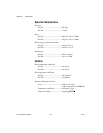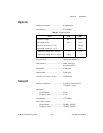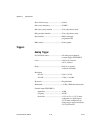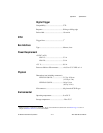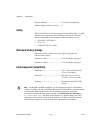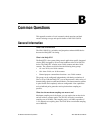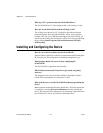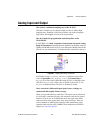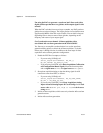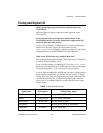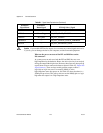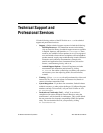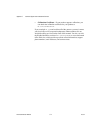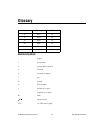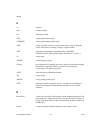Appendix B Common Questions
NI 6115/6120 User Manual B-4 ni.com
I’m using the DACs to generate a waveform, but I discovered with a
digital oscilloscope that there are glitches on the output signal. Is this
normal?
When the DAC switches from one voltage to another, any DAC produces
glitches due to released charges. The largest glitches occur when the most
significant bit (MSB) of the D/A code switches. You can build a lowpass
deglitching filter to remove some of these glitches, depending on the
frequency and nature of your output signal.
Can I synchronize a one-channel AI data acquisition with a
one-channel AO waveform generation on the NI 6115/6120?
Yes. One way to accomplish synchronization is to use the waveform
generation timing pulses to control the AI data acquisition. To do this,
follow steps 1 through 4 below, in addition to the usual steps for data
acquisition and waveform generation configuration.
1. Enable the PFI5 line for output, as follows:
• If you are using NI-DAQ, call
Select_Signal(deviceNumber, ND_PFI_5,
ND_OUT_UPDATE, ND_HIGH_TO_LOW)
.
• If you are using LabVIEW, select Data Acquisition»Calibration
and Configuration»Route Signal.vi from the function palette
and set signal name to
PFI5 and signal source to AO Update.
2. Set up data acquisition timing so that the timing signal for A/D
conversion comes from PFI5, as follows:
• If you are using NI-DAQ, call
Select_Signal(deviceNumber, ND_IN_SCAN_START,
ND_PFI_7, ND_HIGH_TO_LOW)
.
• If you are using LabVIEW, select Data Acquisition»Analog
Input»Advanced Analog Input»AI Clock Config.vi with clock
source code set to
PFI pin, high to low, and clock source
string set to
5.
3. Initiate AI data acquisition, which starts only when the AO waveform
generation starts.
4. Initiate AO waveform generation.



